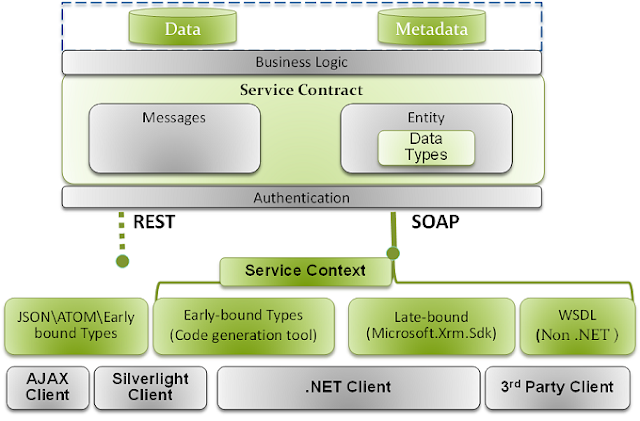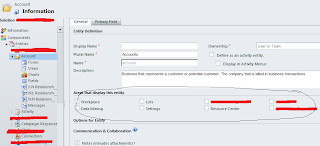MS Dynamics CRM 2011 provides two Web services. These services can be used to identify your organization and to access MS Dynamics CRM data.
IDiscoveryService Web Service - A single MS Dynamics CRM installation can host multiple organizations on multiple servers. The IDiscoveryService Web service returns a list of organizations that the specified user belongs to and the URL endpoint address for each organization.
http[s]://< hostname[:port]>/XRMServices/2011/Discovery.svc
To access the IDiscoveryService Web service, use Microsoft.Xrm.Sdk.dll assembly -> Microsoft.Xrm.Sdk.Discovery namespace.
Use the Execute method to execute a discovery service message.
RetrieveOrganizationRequest - Retrieves information about a single organization.
RetrieveOrganizationsRequest - Retrieves information about all organizations to which the user belongs.
RetrieveOrganizationsResponse
IOrganizationService Web Service - The Web service for accessing data and metadata in MS Dynamics CRM 2011
Organization Service Methods - Create, Retrieve, RetrieveMultiple, Update, Delete, Associate ( create a link between two records), Disassociate, Execute
IOrganizationService Entities
Best Practices for Developing with Microsoft Dynamics CRM
IDiscoveryService Web Service - A single MS Dynamics CRM installation can host multiple organizations on multiple servers. The IDiscoveryService Web service returns a list of organizations that the specified user belongs to and the URL endpoint address for each organization.
http[s]://< hostname[:port]>/XRMServices/2011/Discovery.svc
To access the IDiscoveryService Web service, use Microsoft.Xrm.Sdk.dll assembly -> Microsoft.Xrm.Sdk.Discovery namespace.
Use the Execute method to execute a discovery service message.
RetrieveOrganizationRequest - Retrieves information about a single organization.
RetrieveOrganizationsRequest - Retrieves information about all organizations to which the user belongs.
RetrieveOrganizationsResponse
IOrganizationService Web Service - The Web service for accessing data and metadata in MS Dynamics CRM 2011
Organization Service Methods - Create, Retrieve, RetrieveMultiple, Update, Delete, Associate ( create a link between two records), Disassociate, Execute
IOrganizationService Entities
Best Practices for Developing with Microsoft Dynamics CRM





























